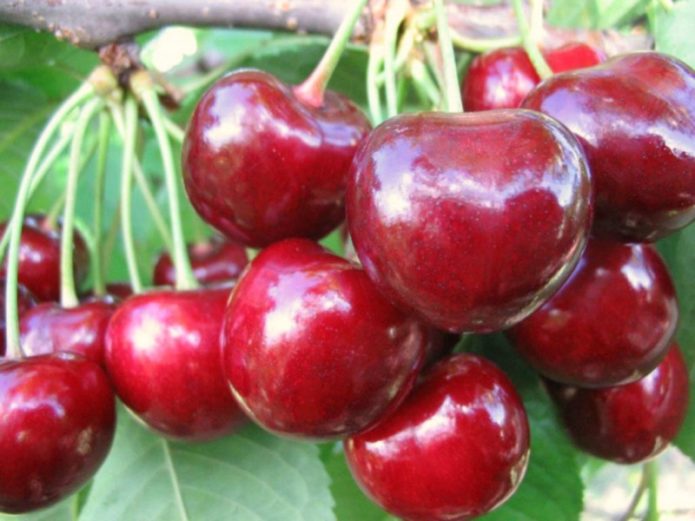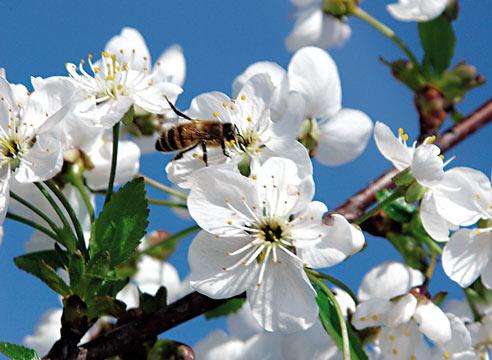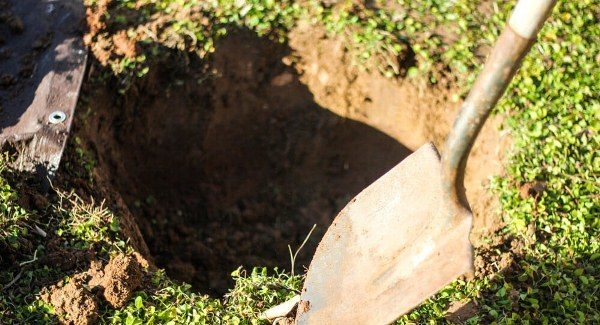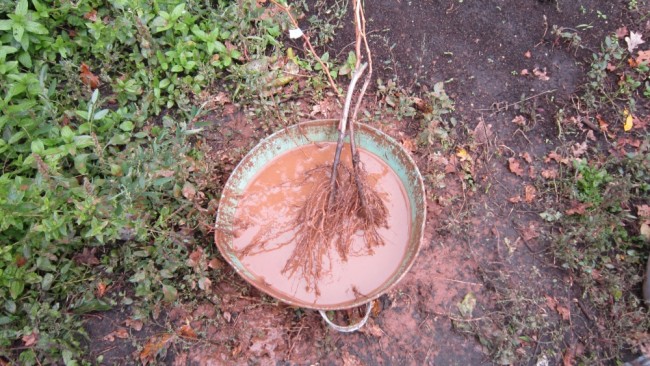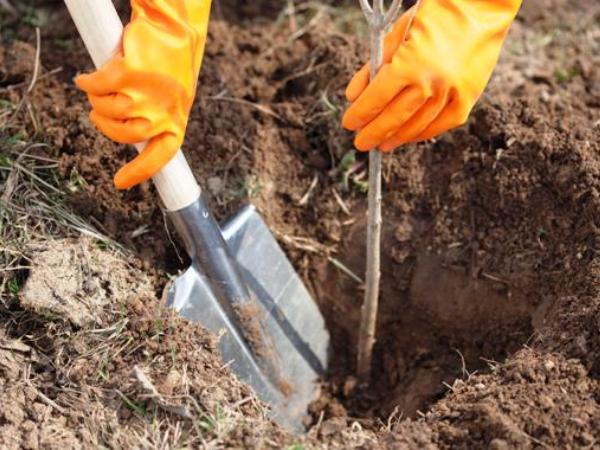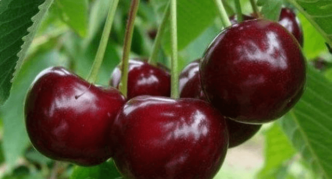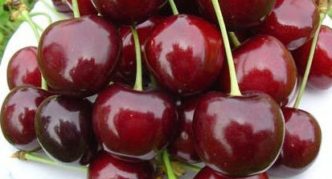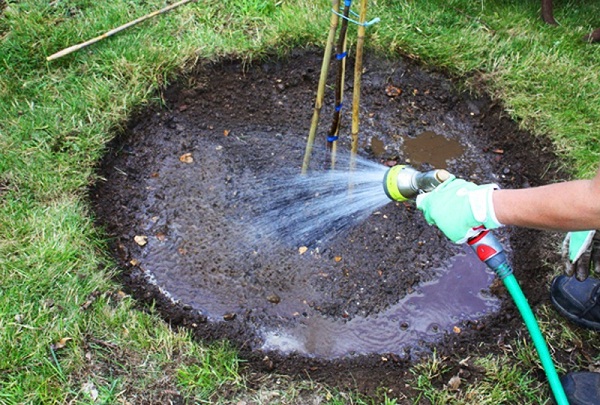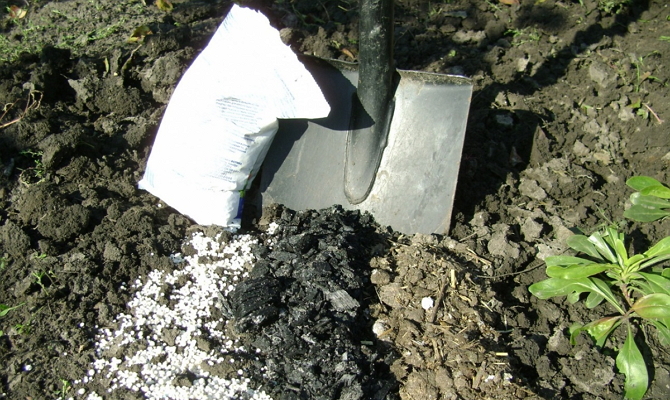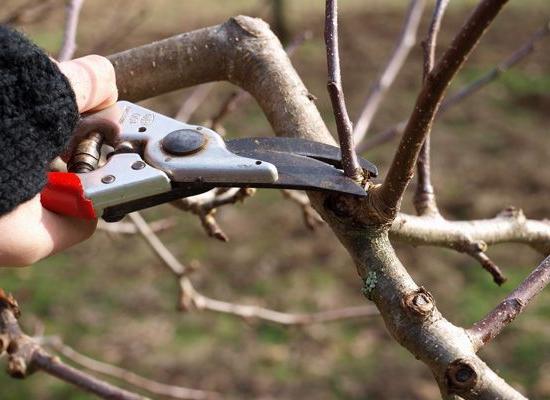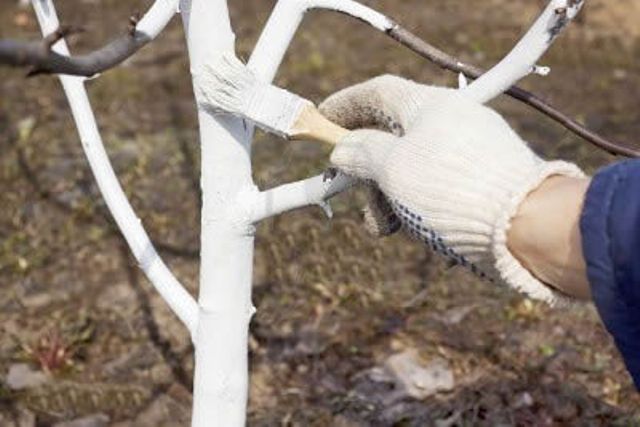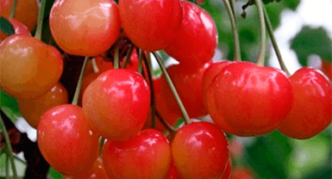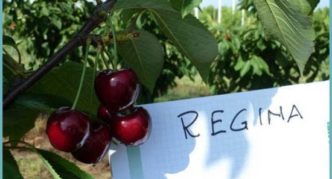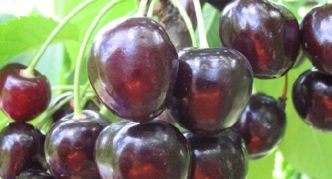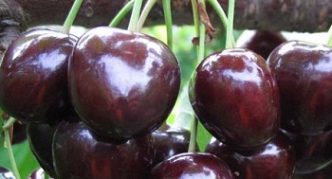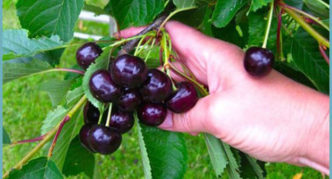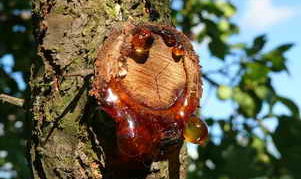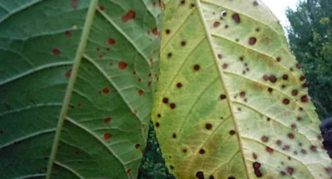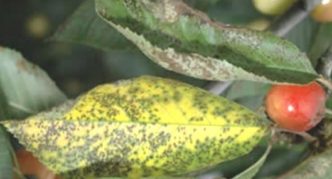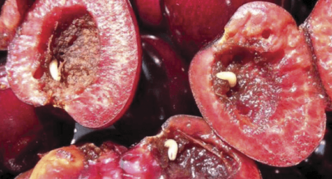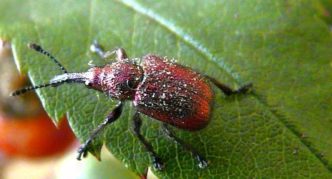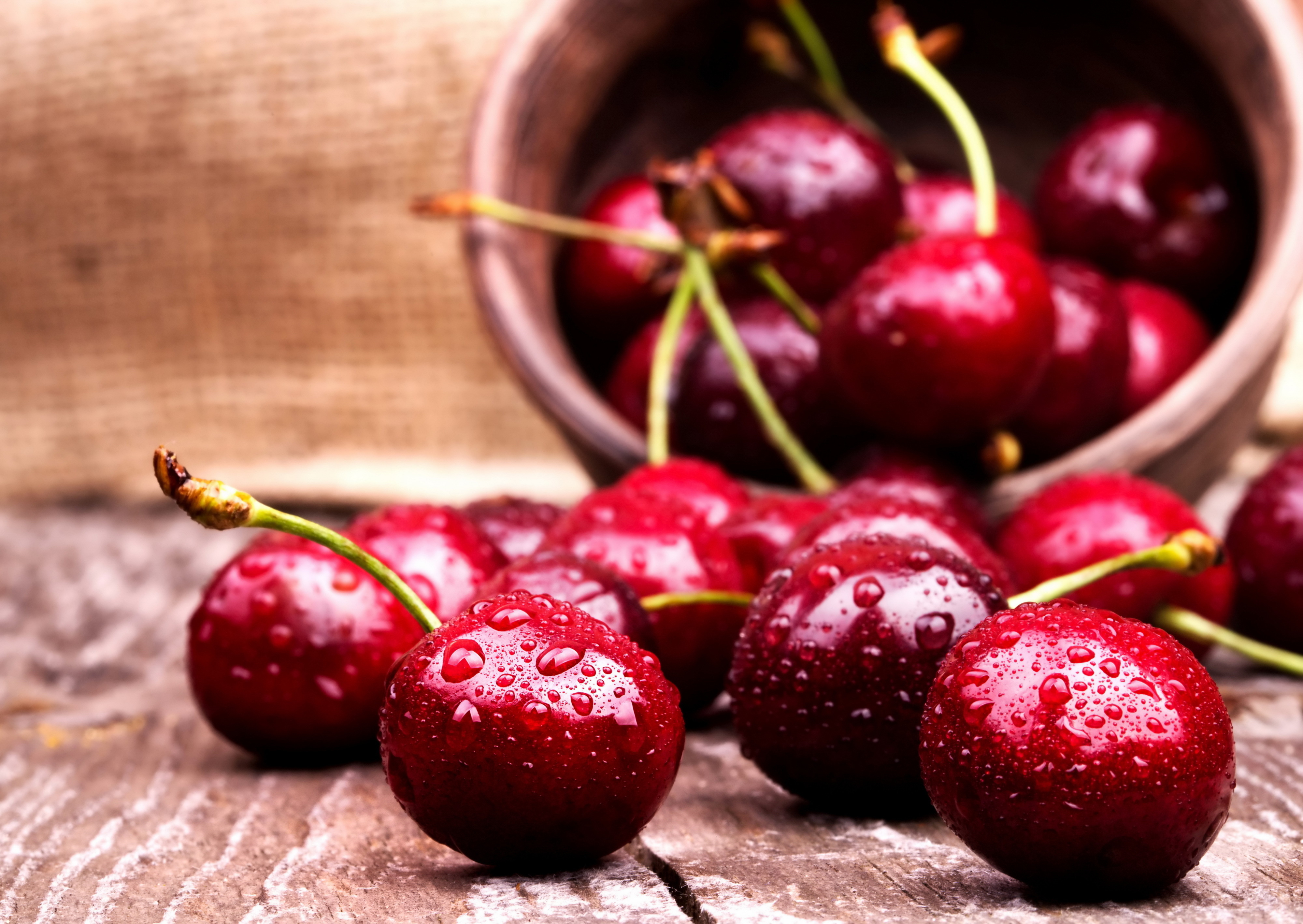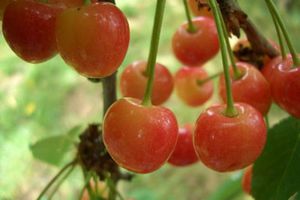The name of the cherry - Large-fruited - speaks for itself. Its fruits, in comparison with berries of other varieties, are real giants. On average, the mass of sweet and juicy cherries is 10–12 g, but they often reach a record weight of 18 g. Gardeners who dream of getting large berries and a large harvest should pay attention to the Large-fruited variety and grow it in their garden.
Content
How did the cherry variety Krupnoplodnaya come about?
Cherry Large-fruited differs from other varieties of culture in the huge size of the fruits. The mid-season variety was obtained by breeders from the Ukrainian Research Institute of Irrigated Horticulture, M.T. Oratovsky and N.I. The new hybrid has adopted all the best from its parents: large size, juiciness and sweetness of the fruit.
The variety Krupnoplodnaya has been on variety testing since 1973; it was included in the State Register of Breeding Achievements of the Russian Federation in 1986.
Cherry Large-fruited is grown not only in the south: in the Krasnodar Territory and Crimea, but also successfully cultivated in the Central region of Russia.
Description of the variety
Adult cherries reach 4–5 m in height, so it is recommended to restrain growth through proper pruning and tree shaping. The skeletal branches are rough and strong, the crown is spherical, moderately thickened.
Large-fruited enters fruiting in the 4th year after planting a seedling. The berries are very large, their average weight is 10–12 g, the maximum weight of individual specimens reaches 18 g. The skin is thin, but dense. The fruits are colored dark red, and the flesh is dark burgundy. The taste of the berries is sweet, sweet, the tasting score is high and is 4.6 points out of 5. The stone is large and easily separates from the pulp.
The leaf blades are large, elongated and slightly pointed, colored bright green. The flowers are quite large, with snow-white petals.
The sweet cherry yield is high, while it bears fruit without rest breaks. Up to 60 kg of universal berries are obtained from one tree, which are good both for fresh consumption and for conservation. They make delicious and aromatic jams, preserves, jellies.
The main pros and cons of growing sweet cherries Large-fruited - table
| Advantages | disadvantages |
| Excellent transportability of fruits | Cracking berries with excess moisture |
| Stable yield | |
| Large berry size | The need for pollinating varieties |
| Resistance to bacterial cancer |
Planting a tree
Sweet cherry does not like when water comes close to the surface of the soil. It also does not tolerate cold winds. When choosing a place to plant a crop, it is necessary to take into account these two very important factors. The best option for placing Large-fruited in the garden would be the sunniest place on the south side of the site.
It is recommended to plant cherries only in spring, when the threat of return frosts has passed. Otherwise, the fragile seedling will simply freeze. If you bought a cherry in the fall, then dig in it and postpone planting until the warm spring days.
Large-fruited is not picky about the composition of the soil, but in order to get an excellent harvest, you need to fertilize the site before planting, and also fill the planting pit well with a nutrient composition. In the fall, dig up the ground and add humus, potassium salt and superphosphate. The dosage of mineral fertilizers is indicated by the manufacturer on the packaging.
How to plant a seedling: instructions
- We dig a hole for planting cherries, its width and depth should be approximately 2 times the root system of the seedling.
- Mix the rotted manure (2 buckets) with a fertile layer of earth, add 100 g of potassium sulfate and 400 g of superphosphate to the substrate and pour the nutrient mixture into the pit.
- We put a layer of ordinary soil on top to avoid contact between the roots and fertilizer.
- We soak the seedlings in water for 12 hours.
- We make a chatterbox from clay, mullein and water. We dip the roots into the mass.
- At the bottom of the planting pit, we make a small tubercle and drive in a peg, to which we will subsequently tie the seedling.
- We straighten the roots and place the seedling on the tubercle.
- Sprinkle with earth, tamp and tie the bole to the peg.
- We make a roller around the seedling, forming a hole, and pour 2 buckets of water into it.
- We mulch the soil with peat, sawdust or dry soil.
The root collar should be raised above ground level. Otherwise, the tree will grow poorly and not bear fruit for a long time.
Planting cherries from A to Z - video
Pollinating varieties for the Large-fruited variety
When planting Aronia, be sure to take into account that the plant needs pollinators to set fruit. Cherry neighbors can be trees of varieties:
- Francis (Francis),
- Bigarro,
- Surprise.
The best pollinating plants for cherries - photo gallery
- Francis is one of the best pollinators for Large-fruited
- In order for the Large-fruited crop to be consistently high, it is necessary to plant several sweet cherry pollinators, for example, Surprise
- The Bigarro variety is not only an excellent pollinator for Large-fruited, but is good in itself for juicy and sweet fruits.
Nuances of agricultural technology varieties Large-fruited
Cherry Large-fruited has established itself as an unpretentious plant. The main agrotechnical techniques for growing crops are weeding and loosening the near-trunk circle, watering and fertilizing.
Watering and feeding
Additional moisturizing cherries are required only in dry periods and too hot days. At this time, 2 buckets of water are poured into the trunk circle. But feeding adult cherries needs regular. Without them, the fruits become smaller and become less juicy and sweet.
In total, it is recommended to carry out 3 dressings per season. The first is held in April. To do this, small grooves with a depth of about 25 cm are dug along the perimeter of the crown. Urea is introduced into them (200 g under one tree), covered with soil and watered abundantly.
The second top dressing is done in late July or early August.During this period, the following are poured into the grooves dug along the perimeter of the crown:
- potassium sulfate (100 g);
- superphosphate (300 g).
In the fall, before digging the trunk circle, 2 buckets of humus are poured under each cherry. Then they mix it with the ground and water the planting abundantly.
Pruning and shaping the crown of a tree
Experienced gardeners advise pruning cherries in the spring, giving the crown the desired shape. Shoots (subordinate branches) are shortened by about a third. This technique stimulates the laying of new fruit buds.
For seedlings grown in a specialized nursery of garden plants, the crown is usually already formed according to all the rules, and in the first years after planting, the gardener does not need to do anything. In the third year, formative pruning should be carried out, retaining 6-9 skeletal branches, while they are also shortened, leaving 60 cm of last year's growth. To strengthen the trunk, on the 4th year after planting, all shoots located below the skeletal ones are removed.
Adult specimens require annual sanitary pruning. All new shoots that extend at an acute angle from the stem or grow vertically are removed.
When pruning branches with a diameter of more than 1 cm, it is imperative to cover the cuts with garden pitch.
Frost protection for cherries
In the fall, after the end of the leaf fall, the trees must be watered abundantly, the trunks and forks must be whitened, and the young specimens must be wrapped in spruce branches to protect them from frost.
In winter, you need to trample the snow around the cherry, after making a snowdrift near the trunk. This agrotechnical technique will protect the tree from freezing and from mice. A strong ice crust that forms around cherries will prevent rodents from making holes in the snow and thus reliably protect the root system from damage.
Other varieties of cherries with large berries
Large-fruited is not the only type of sweet cherry with huge berries, there are others:
- Dyber is black. Large cherries of this variety have a dark red, almost black skin and juicy pulp with a very pleasant aroma. Fruit weight reaches 6 g.
- Yulia. The variety is one of the most winter-hardy, besides the tree looks very attractive. The fruits are creamy yellow with a pink blush.
- Bull heart. The berries weigh 7–8 g, and the taste is excellent. However, the transportability of the fruits is low, therefore, sweet cherries are recommended for growing only in private household plots.
- Melitopol large-fruited. A late-ripening variety with tasty large berries with a heady aroma. The tree does not grow more than 3 m in height, which makes harvesting much easier.
- Regina. The variety, created by German breeders, with large fruits weighing 10-11 g. Resistant to pests and diseases.
Julia, Regina and other large-fruited varieties - photo gallery
- Julia's fruits are very beautiful, they are painted in a creamy shade and have a bright blush
- The average weight of Regina's fruits is 10-11 g
- Dybera black berries are colored in a dark red shade
- Large berries of Melitopol large-fruited have an excellent aroma and attractive appearance
- The weight of sweet cherries of the Bull Heart variety is 7–8 g
Diseases and pests of sweet cherry
Large-fruited has good immunity to various ailments, especially bacterial cancer. But under adverse weather conditions, problems can arise.
Diseases of the Large-fruited variety - table
| Disease | Signs | Ways to fight |
| Holey leaf spot (clasterosporium disease) | On young leaf blades, red spots with a crimson border appear. The affected tissue dries up and crumbles. The berries stop growing and become deformed. | Treat the wood with a 5% solution of copper vitriol in the spring before the leaves appear and in the fall after the fall. |
| Gum therapy | Resin appears on the bark, which subsequently hardens.In these formations, pathogenic bacteria settle, which lead to the drying out of the shoots. |
|
| Scab | Bright yellow spots appear on the leaf blades. Subsequently, they become darker and cracked. |
|
| Monilial burn (moniliosis) | Leaves, ovaries and young twigs dry up unexpectedly. |
|
Signs of cherry diseases - photo gallery
- Monilial burn is manifested by unexpected drying of shoots
- During gum flow, resin appears on the bark, which subsequently hardens
- With clasterosporium disease, the affected tissue of the leaf blade dries up and the leaves crumble
- Bright yellow spots appear on the leaf blades, which subsequently become darker and crack
Insect pests of the Large-fruited variety - table
| Pest | Signs | Ways to fight |
| Cherry fly | The insect damages the berries, they become soft, dark, rot and crumble. |
|
| Aphid | Massive clusters of small black insects appear on young leaves and shoots. | Spray the tree with a solution of Inta-Vir or Decis immediately after the pest appears. |
| Weevil | The insect eats away the buds, buds and ovaries, and the larvae deposited in the seeds damage the berries. | After flowering, spray the cherry with Actellic, diluting the preparation in water according to the instructions. |
The main pests of sweet cherry - photo gallery
- Cherry fly larvae eat juicy cherry flesh
- Weevil eats buds, buds and ovaries
- Aphids are a small insect, clusters of which appear on leaves and young shoots
Gardeners reviews
My cherry is Large-fruited, in the spring it will be three years from planting, has never bore fruit. It grows very intensively.
My large-fruited is not bitter. And it cracks only when there is no rain in April – May, but in June it does.
A very cool variety, but at the time of ripening in the rains it bursts very much. But all the same, the size of berries, transportability, presentation is a bomb. It has been growing for 20 years.
I have a Large-fruited in a dacha near Kanev, they have already taken off the entire crop. Of course, you could wait until it fully ripens, when it becomes red-black and too sweet, but it was experimentally determined that the best sweet-sour taste is obtained about a week before full ripening. Then the transportability is excellent, and the pulp is dense and juicy. Grows in full sun. I was not very happy with the choice of Large-fruited, because it is difficult to find a pollinator for it, it is a lot and often sick, and the fruits crack, which I observe. But the shape of the tree is beautiful, and I decided to leave it.
Today I examined my Large-fruited - it wintered well! It seems like no frost, the buds are alive, I hope to try the berries this season.
How to properly plant cherries and take care of the plant - video
For more than 30 years, large-fruited sweet cherry has been in constant demand among amateur and professional gardeners. The variety is unpretentious, it is distinguished not only by a record weight of berries, reaching 18 g, but also by a high level of frost resistance.
